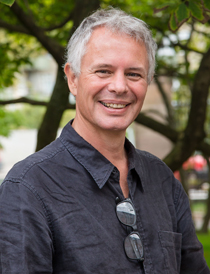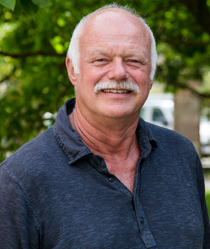Four researchers have 100-year anniversary between them
Four researchers at the Niels Bohr Institute are celebrating their 25th anniversary – collectively they have a 100-year anniversary this year. Three of the researchers are Morten Bo Madsen, Uffe Gråe Jørgensen and Kim Lefmann who are celebrating 25 years as state employees, while Stig Skelboe is celebrating his 25th anniversary as a professor.

Morten Bo Madsen is associate professor and head of the Mars Group at the Niels Bohr Institute.
Morten Bo Madsen is associate professor and the head of the Mars Group at the Niels Bohr Institute. Morten Bo Madsen started studying mathematics, physics and chemistry at Odense University in 1976. In ’79, he moved over to DTU and studied engineering physics and graduated in ’82, specialising in Mössbauer spectroscopy. He continued at DTU and completed his PhD in’86.
One day in the middle of his PhD programme, he was contacted by Jens Martin Knudsen from the Niels Bohr Institute. He wanted to measure a meteorite at a low temperature (4o Kelvin). This was some of the most original material from the solar system. The measurements showed that the meteorite contained ferrihydrite, an iron compound where water is involved in the formation process. “It was incredibly exciting and the discovery was published in Nature, explains Morten Bo Madsen.
In ’89, a position as an assistant professor was advertised at the Niels Bohr Institute and Jens Martin Knudsen was eager for Morten Bo Madsen to apply for the position. He was hired and after participating in a conference on Mars, he started on a quest for Danish Mars research.
Jens Martin Knudsen was invited to participate in a working group under the ESA, which wanted to research Mars. However, it never amounted to anything. But the Americans were interested and invited Jens Martin Knudsen to give a presentation on Mössbauer spectroscopy and here he proposed the idea of measuring the red, iron rich dust on Mars using magnets and suddenly Denmark was invited to NASA’s next Mars mission.
The Mössbauer Group became the Mars Group and Morten Bo Madsen helped to develop magnets for simple instruments that would go with on the next mission, Mars Pathfinder, which was to land on Mars in ’97. The Mars Group developed the magnet instruments and also helped to control the camera instruments on Mars. It went well and the group have since been invited to join the Americans’ next missions, Spirit and Opportunity in 2004, the Phoenix lander in 2008 and the Mars Science Laboratory with the rover Curiosity, which landed in 2012. The Mars Group has recently been invited to join the next mission, the Mars-2020 rover.
The Danish researchers have helped prove that Mars has had flowing water and was once a habitable planet for microorganisms. “It has been an adventure all the way way,” says Morten Bo Madsen, who became the head of the group in 2002 when Jens Martin Knudsen retired.

Uffe Gråe Jørgensen is associate professor and head of the research group Astrophysics and Planetary Science at the Niels Bohr Institute.
Uffe Gråe Jørgensen is associate professor and head of the research group Astrophysics and Planetary Science and area leader for astronomy at the Niels Bohr Institute and is the Danish representative on ESO’s board. He received his MSc from the Astronomical Observatory, part of the University of Copenhagen, in 1980 and was then hired at Uppsala University, where conducted research in stellar evolution. Then he worked for Nordita under the Niels Bohr Institute at the University of Copenhagen for three years. In '87, when a PhD degree was introduced in Denmark, Uffe Gråe wrote a PhD dissertation in three weeks. In 1996, he was hired as an associate professor at the Niels Bohr Institute.
Uffe Gråe has been working with exoplanets since 2003 and this purely by chance. A foreign researcher had approached him with a project to search for potential planets around other stars than the Sun and Uffe Gråe recommended that they use the Danish telescope at La Silla in Chile. The 1½-meter telescope was perfect for projects requiring long time series, but in order to use it, they needed a Danish participant. Uffe Gråe thought this was really exciting and when from being a ‘pro forma’ participant to suddenly being deeply involved as an active researcher and in 2005 he helped discover the first Earth-like planet outside our solar system in the Milky Way.
Today, Uffe Gråe leads a team of 30 researchers from around the world in the hunt for exoplanets. He is involved in the SONG project, which was originally only planned for stellar seismology.

Kim Lefmann is associate professor in the research group Neutron and X-Ray Scattering at the Niels Bohr Institute.
Kim Lefmann is associate professor in the research group Neutron and X-Ray Scattering at the Niels Bohr Institute. He received his MSc from NBI in 1991 and in ’95 he received his PhD with a dissertation on neutron scattering and magnetism at pico-Kelvin temperatures. He carried out the research at Risø, the experiments took place in Berlin and the dissertation itself was under NBI. In ’95 and ’96 he went to Finland and worked with a new research project on the magnetism of atomic nuclei and here they got down to 1/10th of a billionth of a degree from absolute zero (-273.15 degrees C). “It was a world record,” he explains, adding “but the Guinness Book of World Records would not recognise it – it was too strange.”
Then he returned to Risø and worked there from’96 to 2008. At Risø he researched superconductors and magnetic materials. The experiments were carried out using neutron radiation generated by a nuclear reactor. The reactor at Risø was shut down in 2000 and “so we took the measuring equipment under arm and went around Europe and asked who wanted to ‘play’ with us,” explains Kim Lefmann. The research centre PSI, (Paul Scherrer Institute) in Switzerland was very interested and the Danish measuring equipment was installed here and so the Danish researchers were often down there and still are. But there are also research facilities in Berlin, Grenoble, Munich, Oxford as well as in Tennessee and Washington, DC in the United States that they often use.
In 2008, Kim Lefmann came to the Niels Bohr Institute, where he continued his research and a giant new project came into play – the ESS, European Spallation Source. Kim Lefmann helped fight to ensure that the giant research facility would be located in the Øresund Region. After several years of political turmoil over where in Europe it would be located, it was finally agreed that it would be located Lund with the data centre in Copenhagen.
Since then there has really been a lot of work, because now they needed to develop the experiments for the research facility and this is also a big part of Kim Lefmann’s job. The European accelerator project will be the world’s most powerful neutron source for researching materials in physics, chemistry, biology, health, the geosciences and the engineering sciences.

Stig Skelboe is professor in the eScience Group at the Niels Bohr Institute.
Stig Skelboe is professor in the eScience Group at the Niels Bohr Institute. He received his degree in electrical engineering from DTU in ’73 and received his PhD in ’75. In 1983, he did a doctorate in calculation methods for electrical circuits. After the PhD degree, he was a guest researcher at the University of Waterloo in Ontario, Canada.
In 1982, he joined the Department of Computer Science at the University of Copenhagen (DIKU) and from ’86-’88 he was the head of the institute. He became a professor in 1988 and was later a guest professor for a year at the University of Illinois, USA. For three years from ’93-’96, Stig Skelboe was the scientific director at UNI-C, (Danish Agency for IT and Learning under The Danish Ministry of Children and Education).
Stig Skelboe returned to DIKU and was once again the head of the institute from 1999-2007. In April 2009, he came to the Niels Bohr Institute, where he taught scientific computing, among other things. Then, when it was decided in the same year that the research facility ESS (European Spallation Source) would be located in the Øresund Region with the research facility in Lund, he became the director of the data centre – a job he held for three years. The data centre will be located in Copenhagen and will neighbour the new Bohr Building, to be built on the North Campus.
Until then the data centre is being developed at HCØ, where they are working with calculations for the instruments to be developed for ESS as well as calculations for the moderators that will slow down the speed of the neutrons in order to get the correct wavelength for the experiments they need to measure. There are also plans – in connection with the data centre, to build a theory centre with a focus on quantum calculations. This will require much more computing power because “the smaller things get, the bigger the calculations become,” explains Stig Skelboe.
The four researchers will be celebrated at a reception on the 3rd of October.
